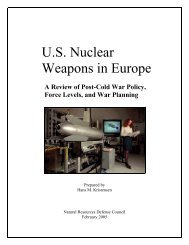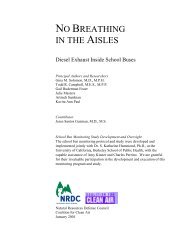p.53-94 (pdf) - Natural Resources Defense Council
p.53-94 (pdf) - Natural Resources Defense Council
p.53-94 (pdf) - Natural Resources Defense Council
Create successful ePaper yourself
Turn your PDF publications into a flip-book with our unique Google optimized e-Paper software.
Appendix C U.S. Nuclear Weapons, Location Profiles, CONTINUED<br />
THE NETHERLANDS<br />
Inçirlik<br />
AIR BASE<br />
COLD WAR NUCLEAR DEPLOYMENTS in Holland included artillery<br />
shells and Lance missile warheads (there were also nuclear<br />
weapons kept for Dutch forces in Germany). For a short time<br />
Woensdrecht air base hosted ground-launched cruise missiles.<br />
Today there is a single nuclear base remaining<br />
Volkel Air Base is a main operating base of the Royal Netherlands<br />
Air Force (Koninklijke Luchtmacht), hosting the F-16A/Bs,<br />
equipping nuclear certified 311 and 312 Squadrons. Volkel is located<br />
two miles from the town of Uden and about 85 miles southeast<br />
of Amsterdam. It was originally established by the German<br />
occupation forces in 1<strong>94</strong>1 and was virtually completely destroyed<br />
prior to its capture at the end of the war. In 1<strong>94</strong>5, it became a training<br />
unit base for Dutch Marines prior to their assignment to Indonesia,<br />
before being turned over to the Royal Netherlands Air Force in<br />
1950. In the early 1960’s, the first U.S. nuclear custodial unit was<br />
established, providing support for the Dutch 1st Fighter Bomber Wing.<br />
The U.S. custodial unit is the 752d MUNNS, subordinate to the 52nd Tactical Fighter Wing at<br />
Spangdahlem. The Squadron is made up of over 100 American personnel. Its predecessor unit, the<br />
717th MUNSS was awarded the nuclear surety plaque in 19<strong>94</strong> “for distinguished performance.” Geographically<br />
separated units of the 52nd Wing also received Quality Air Force Assessments (QAFA)<br />
and nuclear inspections on April 7-11, 1997. The Weapons Storage and Security System (WS3)<br />
vaults reached initial operational capability at Volkel on September 13, 1991. Eleven are operational.<br />
TURKEY<br />
Volkel<br />
AIR BASE<br />
DURING THE COLD WAR TURKEY ranked behind<br />
Germany, the U.K and South Korea as the four largest<br />
nuclear repository overseas. At the height there were<br />
ten separate storage sites with some 500 warheads.<br />
Army nuclear weapons (artillery and Honest John warheads)<br />
were eventually retired and air bases were consolidated,<br />
leaving only InÁirlik Air Base today.<br />
In December 1950, the U.S. and Turkish Air Forces<br />
began work on InÁirlik, the activity started under the<br />
innocuous name “The U.S. Engineering Group<br />
(TUSEG).” The name was later changed to The U.S.<br />
Logistics Group (TUSLOG), a euphemistic code which<br />
served to keep the military profile of U.S. nuclear weapons and intelligence operations in Turkey at a<br />
low level during the Cold War.<br />
InÁirlik Air Base, located seven miles east of the city of Adana, on the northern Mediterranean<br />
coast, is the sole storage location for nuclear weapons in Turkey. The 7216th Air Base Squadron<br />
(TUSLOG Det 10) initially arrived at InÁirlik (then called Adana AB) to operate the base late in 1954,<br />
78 TAKING STOCK
















